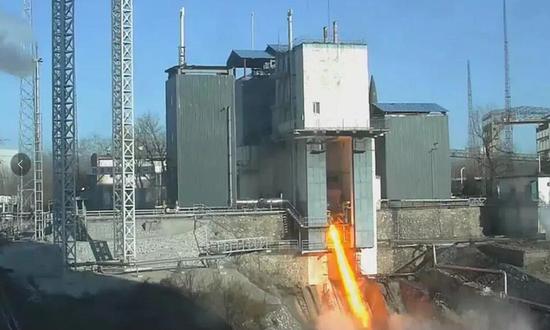China marks a milestone in new-gen heavy-duty rocket devt with successful engine test

The closed expander cycle hydrogen-oxygen rocket engine's first thrust chamber extrusion test in December 2021. (Screenshot photo)
China has successfully conducted a whole-craft running test for its 25 ton-level closed expander cycle hydrogen-oxygen rocket engine for the first time recently, which its developers claimed marked the world's largest scale testing for the kind and a key technology breakthrough for the country's development of the new-generation super heavy-lift launch vehicle.
The CASC revealed on its official website in December 2021 that the closed expander cycle hydrogen-oxygen rocket engine system has the advantages of high performance and high reliability, and has the ability of multiple starts and of large-scale variable thrust adjustment.
It can be used for complex space missions such as manned moon landing, manned Mars landing and deep space exploration, according to the CASC.
According to the CASC, the new engine, the most powerful one of its kind worldwide, is three times stronger than the ones currently deployed for the upper stage of Chinese rocket in active service, and reaches a world leading class. It is a landmark product that China has advanced to the world space power.
When reached by the Global Times on Tuesday, the engine developers with the Sixth Academy of the state-owned aerospace giant China Aerospace Science and Technology Corporation (CASC), declined to provide further details of the new engine model and no video footage is available to show the test process. However, space observers speculated that the new engine system is likely to be used as the third stage and upper stage for the country's highly anticipated Long March-9 super heavy-lift rocket, which would boost China's future space endeavors in the fields including manned Moon and Mars landing, among other deep space exploration programs.
A space expert, who asked not to be named, told the Global Times on Tuesday that the exciting 25-ton engine being tested could be the YF-79 engines, which is even more powerful than the current YF-75D engine atop the Long March-5 - the strongest Chinese launch vehicle to date.
Four such YF-79 engines working in a group to constitute the third stage for the Long March-9 heavy duty vehicle, providing a thrust of some 100 tons, the expert noted.
So far, China has announced a successful running test for its domestically developed 500-ton level liquid-oxygen kerosene rocket engine, which is speculated to be codenamed the YF-130 rocket engine with a 50 percent rated working condition in March 2021; and the completion of the development of a prototype for the 220-ton YF-90 oxygen-hydrogen rocket engine in July 2021, according to media reports.
Space observers said that it seems that the YF-130 rocket engine for the Long March-9 vehicle's first stage, the YF-90 engine for the second stage, and now the YF-79 rocket engine for the third and upper stage have all achieved major development breakthroughs. China is moving closer to the final completion of the heavy-duty launch vehicle which will help the country to develop to be a world space power.
According to what Jiang Jie, the chief designer with the China Academy of Launch Vehicle who is also a China Academy of Sciences academician, has said in March, the development of the super heavy-lift which is of epoch-making significance, would take eight to 10 years.
Space observers noted that according to all the information gathered, the maiden flight for the new generation super heavy-lift vehicle could be expected within the next five year plan of 2026 to 30.
